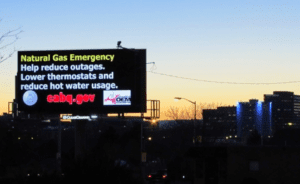Billboard professionals seeking digital billboard permits have heard these arguments from opponents:
- Wait, aren’t digital billboards in federal court?
- What about lighting?
- So are digital billboards safe?
Billboard Insider asked OAAA to prepare a succinct, updated position paper for industry advocates, regarding these common debate points:
- Wait, aren’t digital billboards in federal court?
They were. Since 2013, when Scenic America filed a federal lawsuit against digital billboards, billboard opponents have urged regulators to deny or delay permits for digital billboards due to pending litigation. Scenic America said in published remarks:

“Should the courts rule in our favor, the legality of any existing digital billboards on our roads will be in doubt.” – San Diego Review-Tribune, April 2016
That argument is off the table. A federal appeals court rejected Scenic America’s lawsuit on September 6, 2016.
Steven D. Schwinn of the John Marshall Law School in Chicago said the appeals court dealt Scenic America “a complete loss in the case.”
Schwinn, part of a law professors’ information network, provided a full analysis of this case (Scenic America v. US Department of Transportation et al). OAAA will host a webinar to discuss case results further. OAAA members can register here.
One claim raised by Scenic America could be called the “frozen-in-time” argument. It goes like this:
“… digital billboard technology wasn’t in place when the Highway Beautification Act was enacted in 1965, and, therefore, digital billboards are illegal today because changeable messages are not “customary use.”
The federal appeals court dismissed this argument.
- What about lighting?

A growing number of state and local governments are adopting the industry’s lighting standard, to adjust the brightness of digital billboard lighting to surrounding light conditions (0.3 foot candles over ambient light conditions). Montana is the latest state to adopt this standard, effective August 20, 2016.
The industry standard comes from recommendations developed by Dr. Ian Lewin, former president of the Illuminating Engineering Society of North America (IESNA).
Further, digital billboards are equipped with light sensors to adjust brightness to surrounding conditions.
Federal Guidance to the states, issued in 2007, said:
“Adjust brightness in response to changes in light levels so that the signs are not unreasonably bright for the safety of the motoring public.”
The industry’s practice meets the federal Guidance, which was upheld in federal court on September 6, 2016.
- So are digital billboards safe?

Federal research says digital billboards are not distracting.
On December 30, 2013, FHWA released its long-awaited peer-reviewed research report. The FHWA research was conducted by the respected global engineering firm SAIC (Science Applications International Corporation). It found that glances in the direction of digital billboards are well within the federal safety standard. Read more in The Hill.
The full report is available on the FHWA website by clicking here.
The National Highway Traffic Safety Administration (NHTSA) and other government agencies use digital billboards on behalf of public safety.
Paid Ad

















